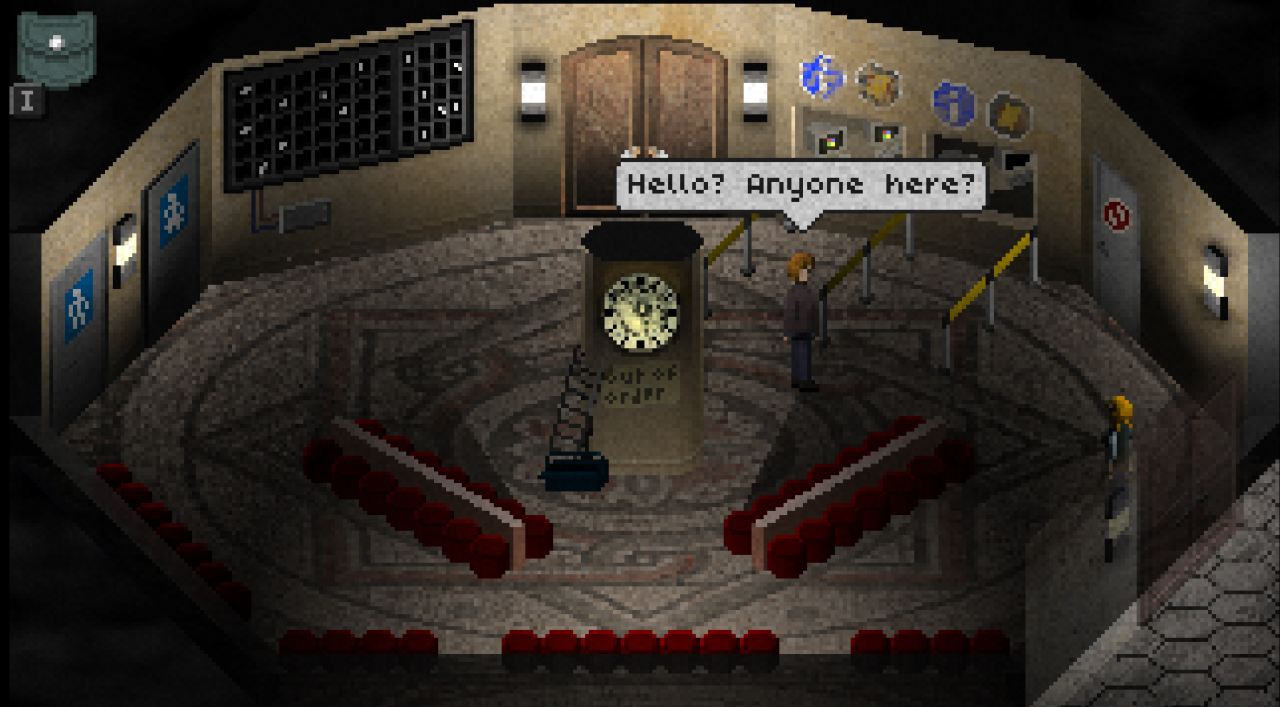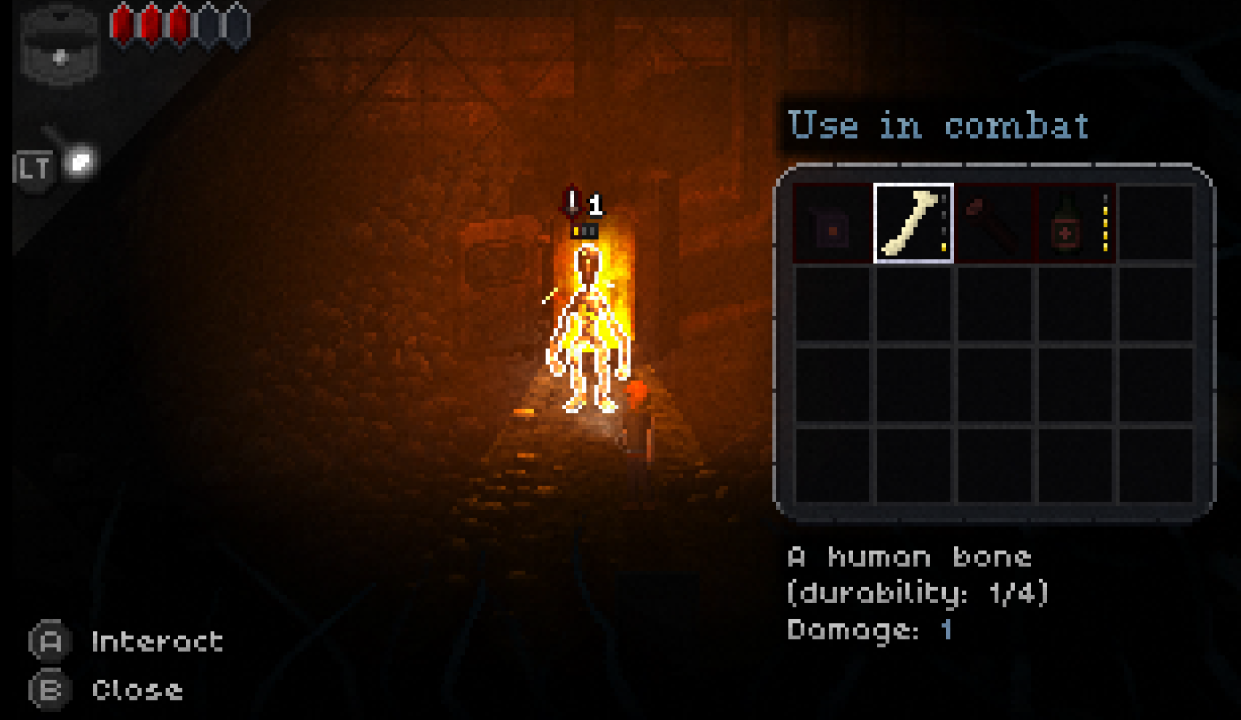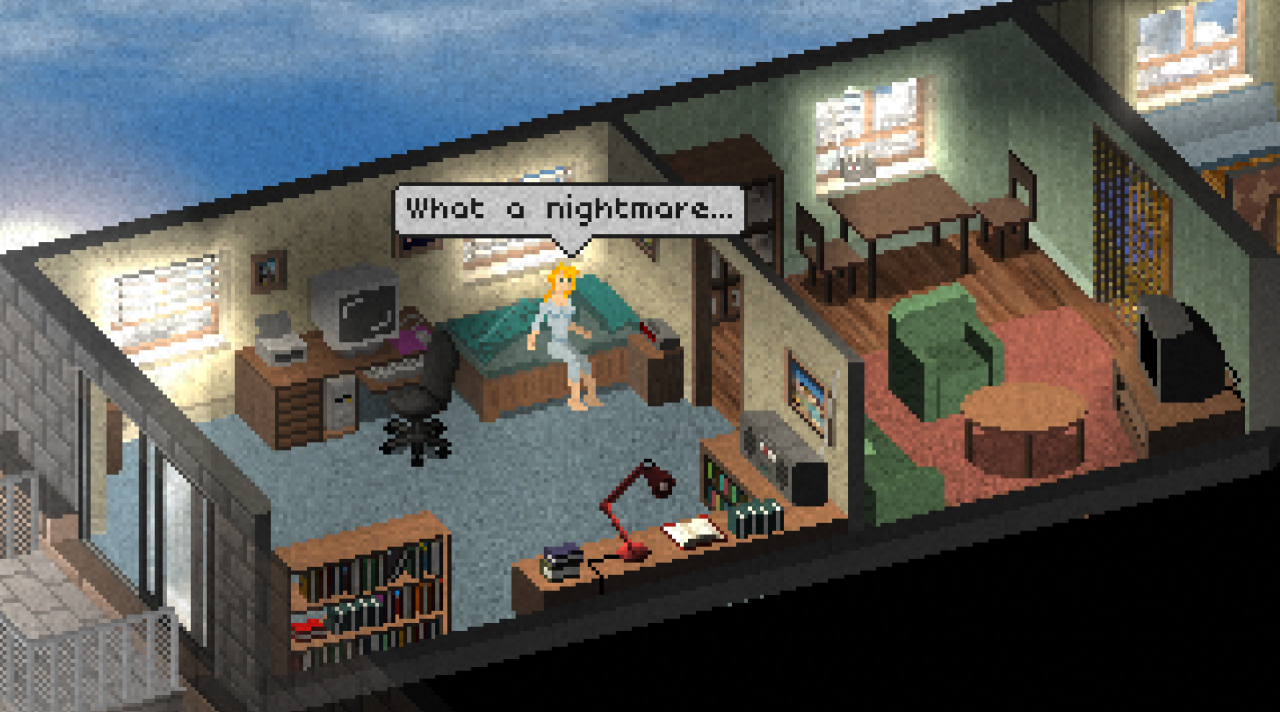A blend of turn-based combat and point-and-click adventure is something I hadn’t encountered; not until Deep Sleep: Labyrinth of the Forsaken filled that gap with a thoughtful story, solid puzzles, and a surprisingly robust combat system. It’s all wrapped in a pixel-art style, steeped in dread, and rich with tension. Deep Sleep may cast you as a dream traveler, but it often feels more like a nightmare—and that’s a very good thing.
Labyrinth of the Forsaken is scriptwelder’s latest game in the Deep Sleep series’ setting. Although its story stands alone from that trilogy, there are obvious points of comparison thematically and in the construction of the adventure systems. There’re shared art assets and ideas, tying the adventure further into its history. If you enjoyed the trilogy, then this latest offering will feel comfortable, even with the additional combat options.
The story follows the young protagonist, Amy, as she journeys through a world of dreams in search of her lost brother. Using a mysterious electronic device, she taps into fragments of his dreams, opening paths to new areas and uncovering clues as to her brother’s fate. This shared subconscious hosts not only other dreamers and travelers but also malignant forces that fuel much of the horror and combat. The writing is strong, with dialogue shaped by careful diction and grammar that give the characters real conviction. As the mystery unfolds, it reveals both the nature of the dream world and Amy’s own circumstances. How did she obtain the device that grants her access to dreams? Why are these specifically her brother’s dreams?
Deep Sleep leans into a retro-pixel art style, using large blocky assets to pack detail into just a few splashes of color. The simplicity doesn’t lessen the atmosphere’s impact. If anything, it sharpens the unease at the heart of the story and setting. Lighting plays a major role (the torch mechanic makes every bump in the night count), while sound design and subtle background movement build a remarkable sense of suspense. The developers clearly have an eye for atmosphere. Mannequins, spiders rustling in the undergrowth, and shifting shadows at the edge of vision are all placed with precision. Each new area had me scanning the screen, bracing for what might emerge. Music is used sparingly, elevating the general suspense. When it does appear, the keyboard-led synth tones place the setting further into its retro inspirations.
The game makes smart use of classic point-and-click conventions. Finding and collecting quest items to unlock new areas and combining items to forge new solutions is satisfying. This is layered with an extra twist: players can rotate inventory objects in pseudo-3D to uncover hidden details or highlight hotspots. Some hotspots trigger reactions, like revealing a key inside a cardboard box or activating a puzzle. Altogether, it’s a sharp evolution of familiar mechanics that keeps item discovery engaging, avoiding the trial-and-error grind of combining everything in the hope of progression.
Environmental puzzles support the item system, with clues woven into the writing and visuals of each scene. Paying close attention always rewards you, and the solutions strike that sweet spot—never unfair, but encouraging you to explore more deeply or reconsider what you already know. A few quirks stand out: items appear in a semi-random fashion due to map randomization, which can sometimes cause you to discard something essential. Since discarded items can’t be recovered, this wrinkle can be frustrating, especially as key objects aren’t marked or distinguished from the rest.
After the first few dreams in Deep Sleep, Amy gains more freedom in where she travels, and repeated dream-walking lets her collect Focus. Focus anchors her to her real self, allowing her to manifest abilities and items within the dream world. As she accrues it, she can spend Focus to unlock powers, boost health, and gain practical perks like larger inventory space (a lifesaver) or faster movement. It’s not the sprawling ability tree of a full RPG, but every upgrade feels meaningful and has immediate impact. Some, like extending her health bar or increasing available Focus, are practically essential.
Beyond stats and abilities, Focus also enables Amy to imprint item blueprints onto her dream self, which she can then summon in dreams. This system enables her to research weapons, shields, or restorative items and prepare strategically for upcoming challenges by creating them in the dream. With enough Focus, you can stockpile items tailored to different encounters like multi-target attacks for swarms, or single-target gear for tougher, isolated foes.
This brings us to combat. When Amy confronts the Shadows of the dream world, confrontations play out in a straightforward turn-based system. Each participant acts in order, marked by numbers beside their sprites, with health clearly tracked. Players choose actions from a simple menu, many of which depend on items carried in the inventory. Tools like wrenches or screwdrivers serve double duty—solving puzzles outside combat and inflicting damage or status effects in battle. Defensive items, such as bin lids or mannequin parts, block attacks for a turn or so.
Every item has a durability rating tied to the strength of its dream imprint or the Focus that Amy invested to create it. While the tactical approaches aren’t vast, the essentials are all here: damage-over-time effects, area attacks, turn delays, and healing abilities. Combat is punishing, largely because of item fragility. The right tool is often in hand, only to crumble before the fight is over. Groups of enemies are especially tough unless you’ve prepared weapons that hit multiple targets, and the challenge spikes once foes start manifesting healing powers of their own. Deep Sleep‘s developers have recently added multiple difficulty options, so this is much less of an issue now than it was at launch.
The end of a dream run (whether you’ve completed it or not) is where you collect Focus to upgrade Amy. There are other options she can take when she is back at her brother’s apartment, and she can choose how to use her free time during the day. These include spending time in the nearby city to build her health levels, or she can read through his book collection to generate additional Focus outside of dream missions.
Deep Sleep nails its story, setting, and the unusual blend of turn-based combat with item-driven adventuring. But a few frustrations hold the experience back, mostly tied to level progression and controlling Amy’s. Each dream can be revisited, yet puzzles, items, and enemies all reset if Amy leaves early. This works fine for combat, where returning stronger or better equipped feels like part of the challenge, but it undermines the point-and-click puzzles. Abandoning a dream means re-entering the same codes, re-discovering the same clues, and re-collecting the same quest items. On one hand, this repetition reflects the cyclical, inescapable nature of dreams. On the other, it slows story momentum and can become frustrating. Controls add to the friction as item selection feels clunkier than it should be, and Amy’s movement isn’t always precise. A gamepad improves traversal over a mouse, but fares poorly in menus, leaving no perfect option.
We are such stuff as dreams are made on, and Deep Sleep: Labyrinth of the Forsaken builds a haunting world on that very idea. Its unsettling art direction, layered puzzles, and imaginative story capture both the wonder and confusion of Amy’s journey. The puzzles are smartly paced, and the turn-based combat adds more tactical depth than expected. My revels may now be ended, but this is a dream worth stepping into. Sleep well.





